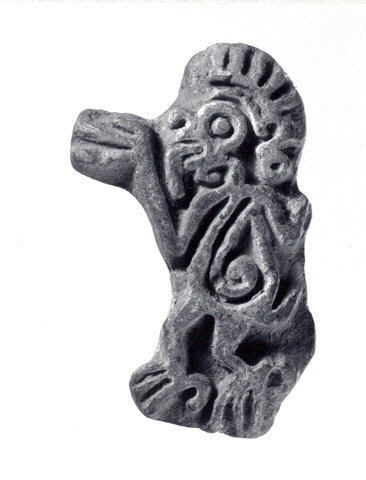Stamp, Monkey
Not on view
This ceramic stamp features the image of a monkey in profile with its arms splayed to either side of its head. The parallel lines radiating out from the monkey’s crown resemble the shock of unkempt hair of the Mexican spider monkey. Its upright stance and flexed knees create a sense of movement in the figure—as if it were walking—while its rotund, helical belly is a playful element of abstraction. As the German archaeologist Eduard Seler long ago noted, in ancient Mexico, the spider monkey was connected with the themes of music, dance, and clowning.
In Nahuatl, the monkey is called ozomatli and is the eleventh day sign of the ancient Aztec calendar. Unlike our calendar today, which consists of twelve months of approximately thirty days each, the Aztecs and other Mesoamerican peoples used "months" of just twenty days. Each day was given a number and named after a different animal or other natural element—for example, "1 Crocodile," "2 Reed," or "4 Movement (Earthquake)."
Monkeys were closely associated with the wind deity Ehecatl, whose teardrop-shaped earrings (epcololli) and split-conch necklaces are often depicted in sculpted images of primates. Almost invariably, artists in the Postclassic period (ca. 900–1521) showed monkeys with large stomachs, animated facial expressions, and attenuated tails that they often hold in their paws.
Ceramic stamps were made in Central Mexico from the Early Formative period (ca. 1800–1200 B.C.) and continued into the early sixteenth century. It is assumed that the earliest examples of such objects functioned much as they did among the Aztecs three millennia later: as ornamental devices used to decorate clothing, ceramic vessels, and even the body. They typically feature abstract geometric designs or stylized animal imagery, often in repeating patterns. Commonly found interred with human remains, these stamps were apparently valued as highly in death as they were in life.
William T. Gassaway, 2014-15 Sylvan C. Coleman and Pamela Coleman Fellow
-----
Resources and Additional Reading
Bierhorst, John. History and Mythology of the Aztecs: The Codex Chimalpopoca. Tucson: University of Arizona Press, 1992.
Miller, Mary E., and Karl Taube. The Gods and Symbols of Ancient Mexico and the Maya: An Illustrated Dictionary of Mesoamerican Religion. London: Thames & Hudson Ltd, 1993.
Sahagún, Bernardino de. The Florentine Codex: A General History of the Things of New Spain. 12 vols. Translated and edited by Arthur J. O. Anderson and Charles E. Dibble. Santa Fe: School of American Research, 1950–82. For creation myth, see Bk. 11 ("Earthly Things").
Seler, Eduard. Gesammelte Abhandlungen zur Amerikanischen Sprach- und Altertumskunde. 5 vols. Berlin: Ascher, 1902–23. See esp. Vol. 4, pp. 456–59.
Taube, Karl. Olmec Art at Dumbarton Oaks. Washington, D.C.: Dumbarton Oaks Research Library and Collection, 2004.
Due to rights restrictions, this image cannot be enlarged, viewed at full screen, or downloaded.
This artwork is meant to be viewed from right to left. Scroll left to view more.




